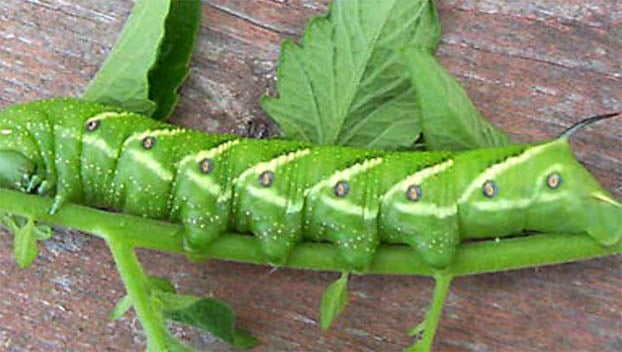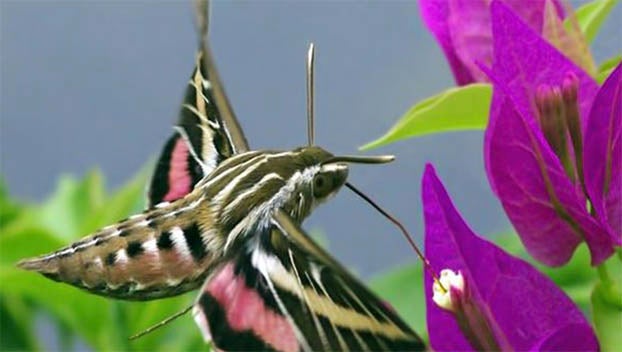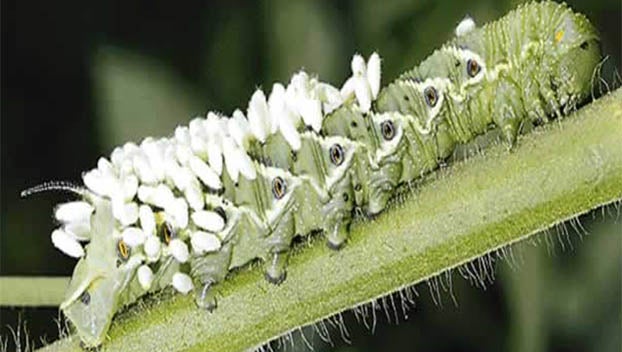Be aware: Hornworms – rapidly defoliate tomato plants
Published 12:01 am Sunday, May 1, 2022

- A hornworm is devouring a tomato plant. (Courtesy of Texas A&M University)
|
Getting your Trinity Audio player ready...
|
Gardeners, for the past week or so, each time I go outside to check my tomato plants, there is an uninvited guest munching away.
Twice each day, morning and evening, I examine each of my tomato plants. Yet, the following morning, huge, grotesque, green caterpillars (with a horn), have stripped away many of the plants’ leaves and stems.
Amazingly, hornworms are difficult to spot, as their unique camouflage completely blends in with the plants’ foliage, providing them unencumbered access to feed on the leaves and fruit of pampered tomato plants everywhere.
By the time I find them, they are enjoying their bountiful meal and have grown large, at 3 to 5 inches long. Meaning they have been voraciously consuming prized tomato plants for several days.
Your tomato plants are healthy and looking great one day and the next day they are decimated-almost stripped bare of leaves and stems! The culprit is either the tomato or tobacco hornworm, both are extremely destructive to tomato plants.
Both hornworm types also consume numerous other plants, many which are within the same family group of plants (which are also known as nightshade plants, or more specifically, vegetable nightshades), including eggplant, pepper, and potato, to name a few.
Fortunately for me, my pepper and eggplants have not been affected thus far but the growing season has barely begun for warm season vegetables like tomatoes, pepper, and eggplants.
The larval stage (caterpillar stage) is when they are most destructive to plants.
They both are overall pale green in color with white/black or yellow/black markings, plus a horn-like protrusion stemming from their rear.
The tomato hornworm has eight “V” shaped yellow/black stripes along its body and a black horn, whereas the tobacco hornworm simply has black/white stripes and a red horn.
To aide in your search, this is what to look for as hornworms start their feeding from the top of the plant.
Check daily for missing or chewed leaves. Look for dark green to black droppings, clinging to the topside of tomato leaves.
Once droppings are located, you’re getting close to locating the hornworms.
The hornworms pupate to become adult moths, which are large, easy to recognize and called the sphinx moth but sometimes referred to as hummingbird moth.
The best ways to eliminate hornworms is to remove them by hand. The thought of handling them is unappealing for most gardeners, but simply put on gloves and crush them unless this causes you too much distress.
If that’s the case, drop them into a bucket of soapy water or if you’re lucky enough to have chickens, they will love you for feeding hornworms to them.
- If the population of hornworms is very large or you have a large garden, you may opt for an organic insecticide, such at Bt, (Bacillus thuringienisis). It is a stomach poison to hornworms once ingested.
- Insecticidal soaps will also eradicate hornworms, but they must have direct contact with the product.
- Till your soil at the beginning and end of each gardening season to destroy any overwintering larvae, this should get about 90 percent of the larvae.
- There are beneficial insects that feed on hornworms, which act as a biological control. Parasitic wasps will lay her eggs on the back of the hornworm and when they hatch, they feed on the hornworm killing it. If you see something that looks like small grains of rice on the back of a hornworm, do not destroy it, move it safely away and allow baby wasps to do their thing.
Written by John Green, a Texas certified master gardener in the Orange County Master Gardeners. If you have specific gardening questions or need more information, contact the Orange County Master Gardeners Helpline at 409-882-7010 or visit txmg.org/orange or Facebook: Orange County Texas Master Gardeners Association. Email extension@co.orange.tx.us.







